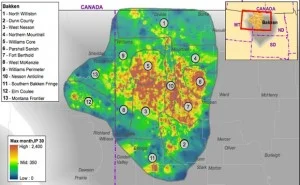According to the oil and gas research and consulting firm Wood Mackenzie, $15 billion will be spent on drilling and completion in the Bakken in 2014, second only to the Eagle Ford Shale. This year, oil production is expected to reach the 1 million b/d mark, and grow markedly beyond that figure over the next 5 - 6 years.
Read more: Bakken Production Sets Another Record - More Than 10,000 ND Wells Producing
“We expect Bakken/Three Forks oil production to average 1.1 million barrels a day (b/d) in 2014, growing to 1.7 million b/d in 2020,” says Jonathan Garrett, upstream research analyst for Wood Mackenzie.”
The firm's analysis shows the Bakken and Three Forks plays hold close to $118 billion in value. Despite infrastructure concerns, estimates indicate operators will recover more than 20 billion bbls of oil reserves throughout the life of the play.
Continental Remains Top Bakken Operator
In 2014, Continental Resources remains the top Bakken operator, with more than 1.2 million acres according to Wood Mackenzie. The value of the company's proved reserves in the Bakken are ~ $14.5 billion.
Read more: Continentals Proved Reserves in the Bakken Valued at $14.5 Billion
In 2013, Continental conducted multiple tests of the Three Forks . Wood Mackenzie indicates the company has the most advanced delineation program in the deeper Three Forks benches.
Wood Mackenzie Analysis of Bakken Three Forks Sub-Plays
Current figures show the highest initial production rates are on the Nesson Anticline sub-play, with 30-day IP rates of 1000 boe/d. Estimated ultimate recovery (EUR) rates are the highest in the Fort Berthold sub-play at nearly 700,000 barrels of oil equivalent (boe).
In the Southern fringe sub-play, wells targeting the Three Forks formation outperformed Bakken wells. Similar results for Three Forks wells were also found in the North Williston and Williams Perimeter sub-plays.
Wood Mackenzie also indicates in their report that infrastructure constraints will not impact the pace of the play's development. Currently, 73% of crude leaves the Williston Basin by rail.
Read more at woodmac.com

